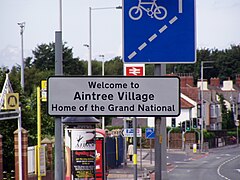
Maghull is a town and civil parish in Sefton, Merseyside. The town is north of Liverpool and west of Kirkby. The area also contains Ashworth Hospital.
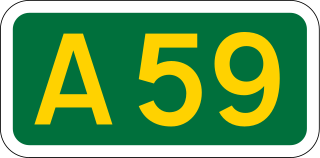
The A59 is a major road in England which is around 109 miles (175 km) long and runs from Wallasey, Merseyside to York, North Yorkshire. The alignment formed part of the Trunk Roads Act 1936, being then designated as the A59. It is a key route connecting Merseyside at the M53 motorway to Yorkshire, passing through three counties and connecting to various major motorways. The road is a combination of historical routes combined with contemporary roads and a mixture of dual and single carriageway. Some sections of the A59 in Yorkshire closely follow the routes of Roman roads, some dating back to the Middle Ages as salt roads, whilst much of the A59 in Merseyside follows Victorian routes which are largely unchanged to the present day.

Lydiate is a village and civil parish in the Metropolitan Borough of Sefton on Merseyside, England but historically in Lancashire. It is located 1.5 miles (2 km) north of Maghull, with which it has a common history. At the 2001 Census the civil parish of Lydiate had a population of 6,672, reducing to 6,308 at the 2011 Census.
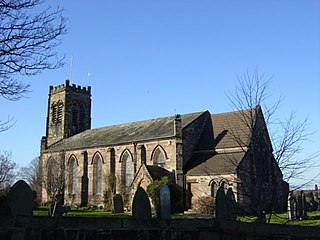
Melling is a village and civil parish within the Metropolitan Borough of Sefton, in Merseyside, England. At the 2001 Census the population was recorded as 2,810, rising to 3,493 at the 2011 Census. Melling Rock contains a public house as well as St Thomas and the Holy Rood. The town of Waddicar, of which most of the population of Melling consists, is usually regarded as part of Melling itself and is served by the parish council which is based in the local Melling Primary School.

Walton is an area of Liverpool, England, north of Anfield and east of Bootle and Orrell Park. Historically in Lancashire, it is largely residential, with a diverse population.

Scarisbrick is a village and civil parish in West Lancashire, England. The A570, the main road between Ormskirk and Southport, runs through Scarisbrick, and much of the village lies along it. As a result, it does not have a traditional village centre, though the junction with the A5147 is close to the geographic centre.

Netherton is an area of the Metropolitan Borough of Sefton, in Merseyside, England.
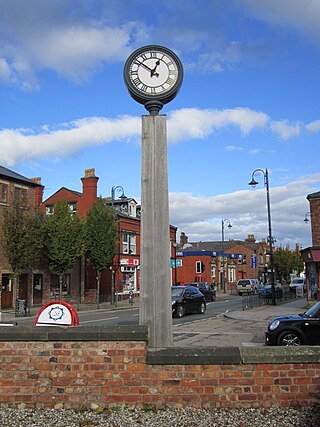
Burscough is a town and civil parish in West Lancashire in the ceremonial county of Lancashire, England. It is located to the north of Ormskirk and northwest of Skelmersdale.

Longton is a village and civil parish in the west of the borough of South Ribble, Lancashire, England. It is about 4 miles to the south west of Preston. The population of the civil parish, which also includes the village of New Longton, was 5,500 at the 2001 Census increasing to 7,652 at the 2011 Census.
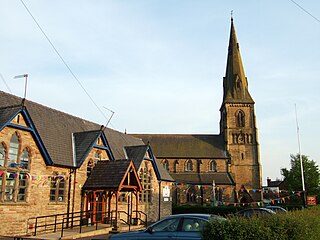
Tarleton is a village and civil parish in the borough of West Lancashire, Lancashire, England. It situated in the Lancashire mosslands approximately 10 miles north east of Southport, approximately 10 miles south west of Preston, approximately 10 miles west of the town of Chorley, and approximately 10 miles north of Ormskirk. The village is known for farming due to its rich soil quality. The parish also includes the village of Mere Brow and the hamlets of Sollom and Holmes.

Old Roan railway station is a railway station in Aintree village, Merseyside, England, about seven miles north-east of Liverpool, on the Ormskirk Branch of the Northern Line of the Merseyrail network.

Rufford is a village in West Lancashire, England, where the Leeds and Liverpool Canal, Liverpool, Ormskirk and Preston Railway, the A59 and the River Douglas meet.
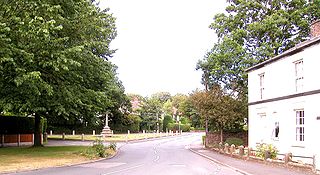
Aughton is a village and civil parish in the Borough of West Lancashire of Lancashire, England, between Ormskirk and Maghull. It is a residential area with tree lined roads being found in all parts of the parish and an area of 1,658 hectares. The northern part is known as Aughton village, the south-west as Holt Green and the south-east as Town Green.
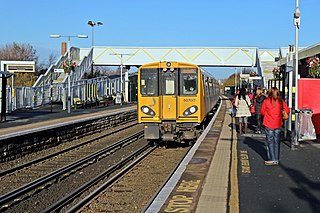
Aintree railway station is a railway station that serves the village of Aintree, Merseyside, England. It is on the Ormskirk branch of the Merseyrail network's Northern Line. Until 1968 it was known as Aintree Sefton Arms after a nearby public house. The station's design reflects that it is the closest station to Aintree Racecourse, where the annual Grand National horse race takes place.
The Southport & Cheshire Lines Extension Railway was an early British railway company operating in the then county of Lancashire. It was constructed to link the Cheshire Lines Committee railway at Aintree to Southport. It operated from 1884 to 1952.

Much Hoole is a village and civil parish in the borough of South Ribble, Lancashire, England. The parish of Much Hoole had a population of 1,851 at the time of the 2001 census, increasing to 1,997 at the 2011 Census.
Hutton is a village and civil parish in Lancashire, England. It is located 3 miles (4.8 km) south west of Preston, in the South Ribble borough and parliamentary constituency. The population of the civil parish at the 2011 census was 2,277.
Kennessee Green is a village in the southern half of Maghull in Metropolitan Borough of Sefton, Merseyside, England. Kennessee Green has two churches: St Andrew's Church and St. Georges Church. The village of Kennessee Green is situated around Maghull railway station, St Andrew's Church and the former epileptic homes located around Damfield Lane and Deyes Lane. The village also contains two high schools, Deyes High School and Maricourt High School.

Westhead is a village in the West Lancashire district of Lancashire, England. As of 2014, the estimated population was 886.
